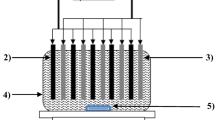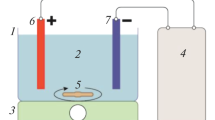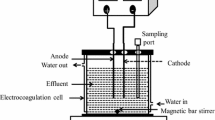Abstract
Performance of an electrocoagulation (EC) process in batch and continuous operating modes was thoroughly investigated and evaluated for enhancing wastewater phosphorus removal under various operating conditions, individually or combined with initial phosphorus concentration, wastewater conductivity, current density, and electrolysis times. The results revealed excellent phosphorus removal (72.7–100%) for both processes within 3–6 min of electrolysis, with relatively low energy requirements, i.e., less than 0.5 kWh/m3 for treated wastewater. However, the removal efficiency of phosphorus in the continuous EC operation mode was better than that in batch mode within the scope of the study. Additionally, the rate and efficiency of phosphorus removal strongly depended on operational parameters, including wastewater conductivity, initial phosphorus concentration, current density, and electrolysis time. Based on experimental data, statistical model verification of the response surface methodology (RSM) (multiple factor optimization) was also established to provide further insights and accurately describe the interactive relationship between the process variables, thus optimizing the EC process performance. The EC process using iron electrodes is promising for improving wastewater phosphorus removal efficiency, and RSM can be a sustainable tool for predicting the performance of the EC process and explaining the influence of the process variables.







Similar content being viewed by others
References
Adjeroud N, Dahmoune F, Merzouk B, Leclerc J-P, Madani K (2015) Improvement of electrocoagulation–electroflotation treatment of effluent by addition of Opuntia ficus indica pad juice. Sep Purif Technol 144:168–176
Akbal F, Camcı S (2011) Copper, chromium and nickel removal from metal plating wastewater by electrocoagulation. Desalination 269:214–222
Al-Harahsheh M, Batiha M, Kraishan S, Al-Zoubi H (2014) Precipitation treatment of effluent acidic wastewater from phosphate-containing fertilizer industry: characterization of solid and liquid products. Sep Purif Technol 123:190–199
Anderson DM, Glibert PM, Burkholder JM (2002) Harmful algal blooms and eutrophication: nutrient sources, composition, and consequences. Estuaries 25:704–726
Anderson DM, Burkholder JM, Cochlan WP, Glibert PM, Gobler CJ, Heil CA, Kudela RM, Parsons ML, Rensel JEJ, Townsend DW, Trainer VL, Vargo GA (2008) Harmful algal blooms and eutrophication: examining linkages from selected coastal regions of the United States. Harmful Algae 8:39–53
Bayar S, Yilmaz AE, Boncukcuoğlu R, Fìl BA, Kocakerìm MM (2013) Effects of operational parameters on cadmium removal from aqueous solutions by electrochemical coagulation. Desalin Water Treat 51:2635–2643
Bayar S, Boncukcuoğlu R, Yilmaz AE, Fil BA (2014) Pre-treatment of pistachio processing industry wastewaters (PPIW) by electrocoagulation using Al plate electrode. Sep Sci Technol 49:1008–1018
Can BZ, Boncukcuoglu R, Yilmaz AE, Fil BA (2014) Effect of some operational parameters on the arsenic removal by electrocoagulation using iron electrodes. J Environ Health Sci Eng 12:95
Chen G (2004) Electrochemical technologies in wastewater treatment. Sep Purif Technol 38:11–41
Conley DJ, Paerl HW, Howarth RW, Boesch DF, Seitzinger SP, Havens KE, Lancelot C, Likens GE (2009) Controlling eutrophication: nitrogen and phosphorus. Science 323:1014–1015
Daneshvar N, Oladegaragoze A, Djafarzadeh N (2006) Decolorization of basic dye solutions by electrocoagulation: an investigation of the effect of operational parameters. J Hazard Mater 129:116–122
Deliyanni EA, Peleka EN, Lazaridis NK (2007) Comparative study of phosphates removal from aqueous solutions by nanocrystalline akaganéite and hybrid surfactant-akaganéite. Sep Purif Technol 52:478–486
Heisler J, Glibert PM, Burkholder JM, Anderson DM, Cochlan W, Dennison WC, Dortch Q, Gobler CJ, Heil CA, Humphries E, Lewitus A, Magnien R, Marshall HG, Sellner K, Stockwell DA, Stoecker DK, Suddleson M (2008) Eutrophication and harmful algal blooms: a scientific consensus. Harmful Algae 8:3–13
Hosni K, Ben Moussa S, Ben Amor M (2007) Conditions influencing the removal of phosphate from synthetic wastewater: influence of the ionic composition. Desalination 206:279–285
Huang H, Liu J, Ding L (2015) Recovery of phosphate and ammonia nitrogen from the anaerobic digestion supernatant of activated sludge by chemical precipitation. J Clean Prod 102:437–446
Huang H, Zhang D, Zhao Z, Zhang P, Gao F (2017) Comparison investigation on phosphate recovery from sludge anaerobic supernatant using the electrocoagulation process and chemical precipitation. J Clean Prod 141:429–438
Lacasa E, Cañizares P, Sáez C, Fernández FJ, Rodrigo MA (2011) Electrochemical phosphates removal using iron and aluminium electrodes. Chem Eng J 172:137–143
Lai TM, Dang HV, Nguyen DD, Yim S, Hur J (2011) Wastewater treatment using a modified A2O process based on fiber polypropylene media. J Environ Sci Health A 46:1068–1074
Li Y, Liu C, Luan Z, Peng X, Zhu C, Chen Z, Zhang Z, Fan J, Jia Z (2006) Phosphate removal from aqueous solutions using raw and activated red mud and fly ash. J Hazard Mater 137:374–383
Lin L, Wan C, Lee D-J, Lei Z, Liu X (2014) Ammonium assists orthophosphate removal from high-strength wastewaters by natural zeolite. Sep Purif Technol 133:351–356
Martínez-Huitle CA, Brillas E (2009) Decontamination of wastewaters containing synthetic organic dyes by electrochemical methods: a general review. Appl Catal B Environ 87:105–145
Mollah MYA, Morkovsky P, Gomes JAG, Kesmez M, Parga J, Cocke DL (2004) Fundamentals, present and future perspectives of electrocoagulation. J Hazard Mater 114:199–210
Monclús H, Sipma J, Ferrero G, Comas J, Rodriguez-Roda I (2010) Optimization of biological nutrient removal in a pilot plant UCT-MBR treating municipal wastewater during start-up. Desalination 250:592–597
Nguyen D-D, Kim S-D, Yoon Y-S (2014a) Enhanced phosphorus and COD removals for retrofit of existing sewage treatment by electrocoagulation process with cylindrical aluminum electrodes. Desalin Water Treat 52:2388–2399
Nguyen DD, Ngo HH, Yoon YS (2014b) A new hybrid treatment system of bioreactors and electrocoagulation for superior removal of organic and nutrient pollutants from municipal wastewater. Bioresour Technol 153:116–125
Nguyen DD, Ngo HH, Guo W, Nguyen TT, Chang SW, Jang A, Yoon YS (2016) Can electrocoagulation process be an appropriate technology for phosphorus removal from municipal wastewater? Sci Total Environ 563–564:549–556
Rajeshwar K, Ibanez JG (1997) Environmental electrochemistry: fundamentals and applications in pollution abatement. Elsevier Science & Technology Books, Amsterdam 804 pp
Sommariva C, Converti A, Del Borghi M (1997) Increase in phosphate removal from wastewater by alternating aerobic and anaerobic conditions. Desalination 108:255–260
Tran N, Drogui P, Blais J-F, Mercier G (2012) Phosphorus removal from spiked municipal wastewater using either electrochemical coagulation or chemical coagulation as tertiary treatment. Sep Purif Technol 95:16–25
Wang X-H, Wang X, Huppes G, Heijungs R, Ren N-Q (2015) Environmental implications of increasingly stringent sewage discharge standards in municipal wastewater treatment plants: case study of a cool area of China. J Clean Prod 94:278–283
Yang S, Yang F, Fu Z, Wang T, Lei R (2010) Simultaneous nitrogen and phosphorus removal by a novel sequencing batch moving bed membrane bioreactor for wastewater treatment. J Hazard Mater 175:551–557
Ye Y, Ngo HH, Guo W, Liu Y, Zhang X, Guo J, B-j N, Chang SW, Nguyen DD (2016) Insight into biological phosphate recovery from sewage. Bioresour Technol 218:874–881
Yildiz E (2004) Phosphate removal from water by fly ash using crossflow microfiltration. Sep Purif Technol 35:241–252
Zelmanov G, Semiat R (2015) The influence of competitive inorganic ions on phosphate removal from water by adsorption on iron (Fe+3) oxide/hydroxide nanoparticles-based agglomerates. J Water Process Eng 5:143–152
Acknowledgements
We are grateful for the research collaboration between Kyonggi University and the University of Technology Sydney. We would also like to thank Dankook University, Gentro Co., Ltd., and former President Dr. S. D. Kim for this research material and advice that made completion of this work possible.
Funding
This project was supported in part by grants from the Korean Ministry of Environment, as a “Global Top Project” (Project No. 2016002210003), and by the New & Renewable Energy Core Technology Program of the Korea Institute of Energy Technology Evaluation and Planning (KETEP) granted financial resource from the Ministry of Trade, Industry & Energy, Republic of Korea (Project No. 20143030101040).
Author information
Authors and Affiliations
Corresponding authors
Additional information
Responsible editor: Bingcai Pan
Highlights
Two electrocoagulation (EC) modes were investigated for phosphorus removal.
Effects of various operational parameters on EC process performance were assessed.
EC process using iron electrodes achieved high, stable phosphate removal efficiency.
Phosphate removal efficiency in COM was higher than that obtained in BOM
RSM analysis was employed to verify the optimization of operating parameters
Rights and permissions
About this article
Cite this article
Nguyen, D.D., Yoon, Y.S., Bui, X.T. et al. Influences of operational parameters on phosphorus removal in batch and continuous electrocoagulation process performance. Environ Sci Pollut Res 24, 25441–25451 (2017). https://doi.org/10.1007/s11356-017-0180-2
Received:
Accepted:
Published:
Issue Date:
DOI: https://doi.org/10.1007/s11356-017-0180-2




